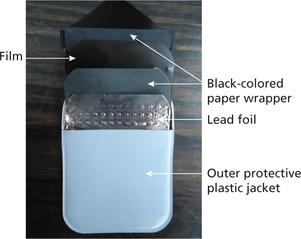Radiographic Films and Accessories
Intraoral Films
Constituents of an Intraoral Film Packet
An intraoral film packet consists of an outer protective jacket, lead foil, black-colored paper wrapper and the film (Figure 1).
Lead foil
Once the outer jacket is opened a thin sheet of lead foil is seen. This lead foil has parallel indentations or markings along the surface in one corner of the foil. If the film is exposed placing the wrong side toward the tube head, these markings are seen on the resultant radiograph. If the wrong side of the film is exposed, though the radiograph will reveal an image, the image will appear light. The markings on the film will help to identify the cause for the underexposed or light radiograph. These markings (diamond markings) are seen on the resultant radiograph. Lead foil is incorporated into the film packet to:
 Minimize the amount of X-rays from passing through the film and interact with the tissues beyond the film and reflect back leading to multiple exposures, thereby minimizing the quality of the final image.
Minimize the amount of X-rays from passing through the film and interact with the tissues beyond the film and reflect back leading to multiple exposures, thereby minimizing the quality of the final image.
 Minimize exposure of the patient’s tissues, which are in line with the X-ray beam but beyond the imaging area.
Minimize exposure of the patient’s tissues, which are in line with the X-ray beam but beyond the imaging area.
Stay updated, free dental videos. Join our Telegram channel

VIDEdental - Online dental courses



